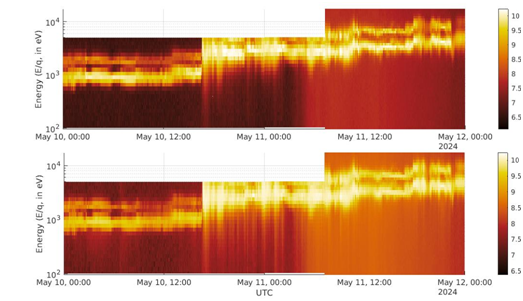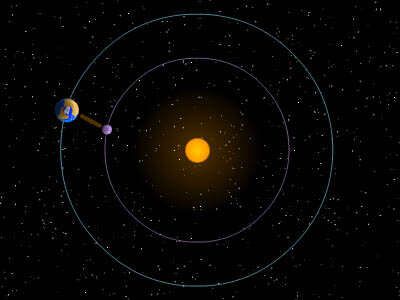India's Aditya-L1,survived high-intensity solar storms without any damage, says ISRO
..ISRO’s fleet of 30 spacecraft in geostationary orbit remained unscathed by the solar onslaught. However, because of precautionary measures the some instruments onboard the INSAT-3DS and INSAT-3DR, used by the India Meteorological Department (IMD), were temporarily shut...
During the recent solar storms that caused major signal disruptions in most parts of the world, and made the aurora borealis appear in a number of unusual places, Indian satellites remained resilient. Despite the onslaught of powerful solar storms, India’s Aditya L-1 and Chandrayaan Satellites stayed completely functional and even took some interesting images and collected data, said the Indian Space Research Organisation (ISRO).
Between May 10 and 11, the Earth was hit as intense solar storms, which originated from the highly active region AR13664 on the sun. This event unleashed a barrage of solar flares, including at least four ‘X’ class (the most intense) and numerous ‘M’ class (moderate intensity) that hit them.
These solar eruptions marked the most potent flares to hit Earth since November 2003. The storms were so powerful that they ignited a spectacular display of aurorae in across numerous places on Earth which usually don’t get to see them. Even some places closer to the equator, such as India’s Ladakh closer got to see them.
Aditya-L1 (आदित्य -L1): Launch and Discussions
Re: Aditya-L1 (आदित्य -L1): Launch and Discussions
India's Aditya-L1, other satellites survived high-intensity solar storms without any damage, says ISRO
Re: Aditya-L1 (आदित्य -L1): Launch and Discussions
India’s Aditya-L1 completes first Halo orbit
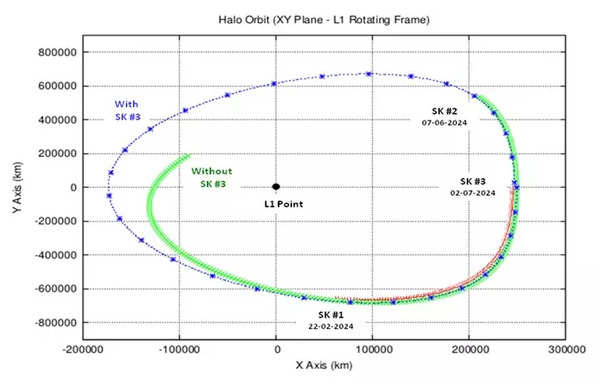

Isro Monday said that India’s first space-based solar observatory, Aditya-L1, has successfully completed its first halo orbit around the Sun-Earth L1 Lagrangian point. The solar observatory, launched on Sept 2, 2023, and inserted into its targeted halo orbit on Jan 6, 2024, has now demonstrated its ability to maintain its complex trajectory.
“The Aditya-L1 mission, designed to study the Sun, takes approximately 178 days to complete one revolution around the L1 point. However, the spacecraft faces various perturbing forces that could cause it to deviate from its intended path. To counter these forces, we’ve performed three crucial station-keeping manoeuvres since the mission’s inception,” Isro said.
The first two manoeuvres took place on Feb 22 and June 7, 2024, respectively. On Monday (July 2), the third manoeuvre marked a critical juncture, ensuring the spacecraft’s transition into its second halo orbit around L1.
This achievement validates the sophisticated flight dynamics software developed in-house at the UR Rao Satellite Centre (URSC) in Bengaluru.
“The mission’s success hinges on the precise modelling of complex dynamics and the accurate understanding of perturbing forces acting on the spacecraft. These factors are crucial in determining the trajectory and planning orbit manoeuvres with high precision,” Isro said.
The space agency also released a diagram illustrating the spacecraft’s orbit, depicted as a blue trajectory projected onto the X-Y plane. The image also shows the potential divergent path (in green) that the spacecraft could have taken without accurate manoeuvring.
As Aditya-L1 continues its journey, it promises to provide valuable insights into solar phenomena, further advancing our understanding of the Sun and its effects on Earth.
Re: Aditya-L1 (आदित्य -L1): Launch and Discussions
^^^ For technical background, please see some old messages about Halo orbits ..(SSalvi and my messages goes through the halo orbits (eg start around this post and see the folllow-up

Eg this:

Eg this:
Amber G. wrote: ↑04 Sep 2023 20:23
Nice, as usual. Let me add: (Without complex math - but for those who are familiar with ordinary orbits).
Lagrange points like L1 exists for sun-earth type systems, where larger body (sun) is at least about 25 times more massive than smaller body ( Earth). This mass ratio is true for Earth-Moon system too.
For simplicity let us assume circular orbits.. around sun. (Actual orbit of earth is ellipse, which makes math a little complex )
Let us just consider sun (as it is massive). Earth which is about 150,000,000 Km away goest around it in 1 year. so do other planets.
At L1 - If we neglect the effect of the earth - a sat will go faster around sun, completing the orbit in less than an year (like Venus etc).
The effect as seen from earth .. Sat will go 'ahead' of sun in a short time..and keep increasing this angular distance)
But Earth is there. It is smaller than sun but L1 is closer to it so it does have influence... it slows L1 -- sorts of drags it with it..
This slowing down is just right enough to keep the sat at the same position (with respect to sun - as seen from earth)..always on the line joining earth/sun.
We call L1, unstable equilibrium. A slight perturbation - 'drag' from earth will not cancel out the difference in centrifugal forces -- and in some time sat will be nothing but another object in an (elliptical) orbit around sun. Nothing stationary now..
These perturbations are there - due to Jupiter, Venus etc which have their own influences.
A sat in the vicinity of L1 goes through complex orbit -- which , if you look from earth resembles a "halo" or a ring. These are complex orbits (in three dimensions).. some are periodic (Halo) and some are not (Lissajous orbits) but they are bounded.
Some periodic "station keeping" is needed to keep these orbits in check -- The fuel requirement is quite low ( My back of envelop calculations -- delta_V about 0.5 m/s ).. but key point here is 'right thrust' at exactly the right time.. So if you have an excellent navigational system, and control system, you can stay for decades with small amount of fuel.
----
Most popular articles do not do justice to describe these orbits properly. For example the size of the orbits is of the order of distance of moon from earth...
Here is a figure, I like to use - to represent the orbit in better perspective -- (Taken from SOHO's orbits)
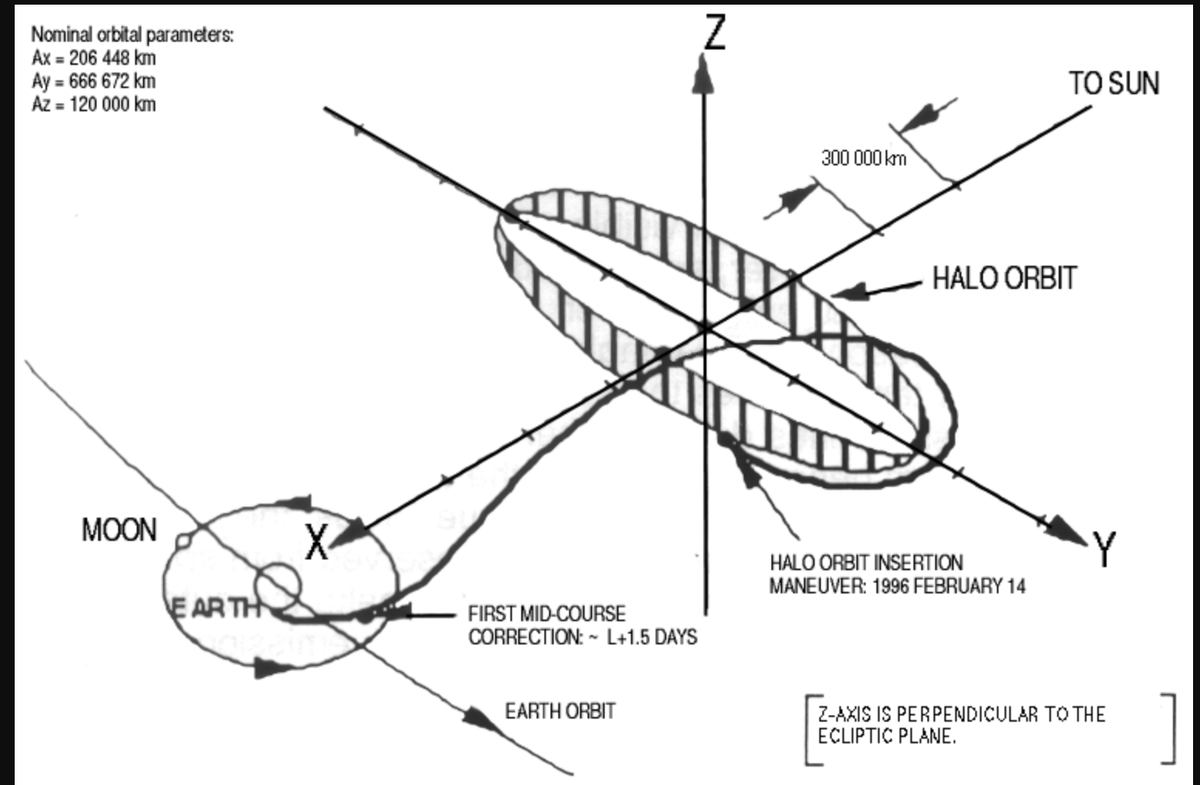
Re: Aditya-L1 (आदित्य -L1): Launch and Discussions
This is from ISRO:
{emphasis and few comments - mine}
Aditya-L1 Mission: Completion of First Halo Orbit
https://www.isro.gov.in/Aditya_L1_Missi ... Orbit.html
July 2, 2024
Today, Aditya-L1 spacecraft has completed its first halo orbit around the Sun-Earth L1 point. The Aditya-L1 mission is an Indian solar observatory at Lagrangian point L1, launched on September 2, 2023 and was inserted in its targeted halo orbit on January 6, 2024. Aditya-L1 spacecraft in the Halo orbit takes 178 days [ about half year ] to complete a revolution around the L1 point.
During its travel in the halo orbit, Aditya-L1 spacecraft will be subjected to various perturbing forces that will cause it to depart from the targeted orbit. It underwent two station-keeping maneuvers on February 22 and June 7, respectively, to maintain this orbit. Today's 3rd station-keeping maneuver has ensured that its travel continued in to thesecond halo orbit path around L1.
This journey of Aditya L1 around Sun-Earth L1 Lagrangian point involves modeling of complex dynamics. The understanding of various perturbing forces acting on the spacecraft helped in determining the trajectory accurately and planning precise orbit maneuvers. With today's maneuver, the state-of-the-art flight dynamics software developed in-house at URSC-ISRO for the Aditya-L1 missions stands fully validated.
The blue trajectory, in the figure, is the orbit around the Lagrangian point L1. This trajectory is a 3 dimensional trajectory, and what is shown is the projection of it in the X-Y plane. SK#1, 2 & 3 are the Station Keeping maneuvers by the Aditya-L1 spacecraft. The final firing of the thrusters, ie. SK#3 on July 2, placed the spacecraft back in the required orbit. If an accurate firing was not done, the spacecraft would have moved away in a trajectory shown in green colour. The X-Y axes are marked in distance of km, with Lagrangian point L1 at the origin.
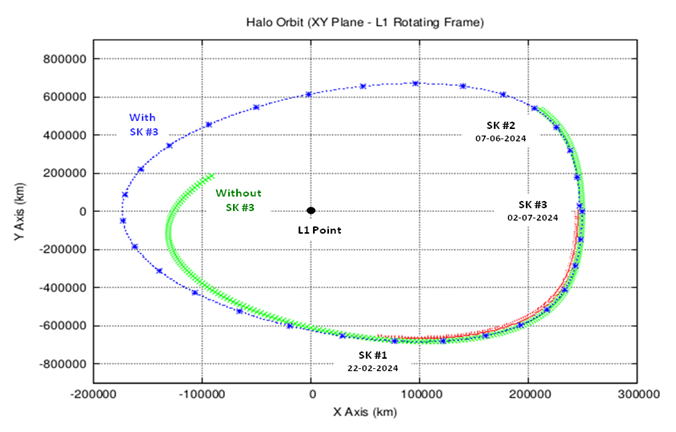
To get perspective on how large is the 'halo orbit' remember the earth-moon distance is about 240,000 Km.
{emphasis and few comments - mine}
Aditya-L1 Mission: Completion of First Halo Orbit
https://www.isro.gov.in/Aditya_L1_Missi ... Orbit.html
July 2, 2024
Today, Aditya-L1 spacecraft has completed its first halo orbit around the Sun-Earth L1 point. The Aditya-L1 mission is an Indian solar observatory at Lagrangian point L1, launched on September 2, 2023 and was inserted in its targeted halo orbit on January 6, 2024. Aditya-L1 spacecraft in the Halo orbit takes 178 days [ about half year ] to complete a revolution around the L1 point.
During its travel in the halo orbit, Aditya-L1 spacecraft will be subjected to various perturbing forces that will cause it to depart from the targeted orbit. It underwent two station-keeping maneuvers on February 22 and June 7, respectively, to maintain this orbit. Today's 3rd station-keeping maneuver has ensured that its travel continued in to thesecond halo orbit path around L1.
This journey of Aditya L1 around Sun-Earth L1 Lagrangian point involves modeling of complex dynamics. The understanding of various perturbing forces acting on the spacecraft helped in determining the trajectory accurately and planning precise orbit maneuvers. With today's maneuver, the state-of-the-art flight dynamics software developed in-house at URSC-ISRO for the Aditya-L1 missions stands fully validated.
The blue trajectory, in the figure, is the orbit around the Lagrangian point L1. This trajectory is a 3 dimensional trajectory, and what is shown is the projection of it in the X-Y plane. SK#1, 2 & 3 are the Station Keeping maneuvers by the Aditya-L1 spacecraft. The final firing of the thrusters, ie. SK#3 on July 2, placed the spacecraft back in the required orbit. If an accurate firing was not done, the spacecraft would have moved away in a trajectory shown in green colour. The X-Y axes are marked in distance of km, with Lagrangian point L1 at the origin.

To get perspective on how large is the 'halo orbit' remember the earth-moon distance is about 240,000 Km.
Re: Aditya-L1 (आदित्य -L1): Launch and Discussions
Meanwhile in the news: Aditya-L1 has successfully analyzed a significant solar event, a Coronal Mass Ejection (CME), which occurred on July 16, 2024. The Visible Emission Line Coronagraph (VELC) onboard Aditya-L1 observed the CME, characterized by a massive ejection of solar plasma and magnetic fields, providing valuable insights into the Sun's dynamic outer atmosphere. The study revealed coronal dimming, a 50% decrease in brightness, increased temperature, and heightened turbulence in the region. The CME's trajectory was influenced by the Sun's magnetic field, causing a deflection in the movement of the ejected material. These findings, published in The Astrophysical Journal Letter, highlight the critical role of Aditya-L1 in understanding solar activity and its impact on space weather, and demonstrate the importance of magnetic forces in predicting CME behavior.
Aditya-L1 Records Coronal Mass Ejection, Reveals New Details on Solar Plasma Movement and Magnetic Activity
Aditya-L1 Records Coronal Mass Ejection, Reveals New Details on Solar Plasma Movement and Magnetic Activity
